SECTION A (25 marks)
Answer all the questions in this section in the spaces provided.
- A micrometer screw gauge has a -0.03 mm error. State the reading that is observed on the instrument when used to measure the diameter of a wire whose actual diameter is 0.38 mm.(1 mark)
- Figure 1 shows a defective straw used to suck milk from a glass.

It was observed that upon sucking the straw, milk did not rise up the straw. Explain this observation (2 marks) - State two ways of reducing the surface tension of a liquid. (2 marks)
- Figure 2 shows a round bottomed flask containing a coloured liquid. The flask is fitted with a capillary tube.
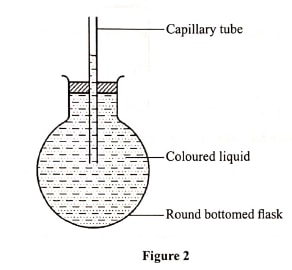
It is observed that on holding the flask with bare hands, the level of the liquid in the capillary tube initially drops slightly and then rises. Explain this observation. (3 marks) - Figure 3 shows two metal rods A and B of equal length made of the same material but different diameters. Wax is attached at one end of each rod. A source is placed between the two metal rods.
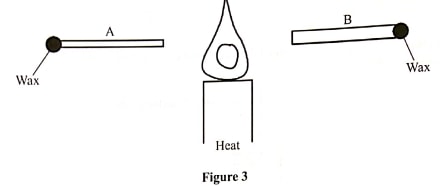
State with a reason, what is observed on the wax. (2 marks) - On the axes provided, sketch a displacement-time graph for a trolley moving down a frictionless inclined plane till it reaches the end of the incline. (1 mark)
- A student carrying a heavy box using the right hand is observed to lean towards the left hand side. Explain this observation. (2 marks)
- Figure 4 shows a one meter long uniform rod of negligible weight supporting two weights.
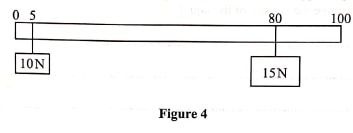
Determine the position of the fulcrum from 0 cm for the rod to remain in equilibrium. (3 marks) - State the meaning of the term "radian" as a unit of measurement (1 mark)
- For a fluid flowing at a velocity V in a tube of cross-sectional area A, VA = constant. State two assumptions made in deriving this equation. (2 marks)
- A stone of volume 800 cm' experiences an upthrust of 6.5 N when fully immersed in a certain liquid. Determine the density of the liquid. (2 marks)
- Figure 5 shows two springs Cand D of the same length and equal number of turns made from the same wire.
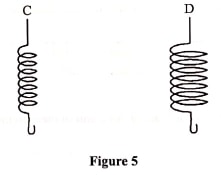
State with a reason which of the two springs can support a heavier load before attaining the elastic limit. (2 marks) - Two boxes E and F of masses 2.0kg and 4.0kg respectively are dragged along a frictionless surface using identical forces. State with a reason which box moves with a higher velocity (2 marks)
SECTION B (55 marks)
Answer all the questions in this section in the spaces provided.
-
- A student is provided with five 20 g masses, a meter rule, a spring with a pointer, a stand, a boss and a clamp.
- In the space provided, sketch a labelled diagram of the set up that may be used in order to verify Hooke's law using these apparatus. (3 marks)
- State two measurements that should be recorded in order to plot a suitable graph so as to verify Hooke's law. (2 marks)
- Describe how the measurements made in (ii) can be used to determine the spring constant. (2 marks)
- A helical spring stretches by 0.6 cm when supporting a weight of 40 g. Determine the extension when the same spring supports a weight of 65 g. (3 marks)
- A student is provided with five 20 g masses, a meter rule, a spring with a pointer, a stand, a boss and a clamp.
-
- Figure 6 shows a bottle top opener being used to open a bottle.
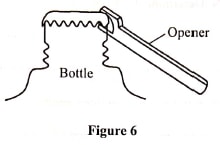
Indicate on the diagram the direction of the load and the effort. (2 marks) - State two ways in which an inclined plane can be made to reduce the applied effort when pulling a load along the plane. (2 marks)
- A block and tackle system has three pulleys in the upper fixed block and two pulleys in the lower movable block.
- Draw a diagram to show how the system can be set up in order to lift a load and indicate the position of the load and effort. (3 marks)
- State the velocity ratio of the set up. (1 mark)
- In such a block and tackle system an effort of 200 N is required to lift a load of 600N. Determine its efficiency. (3 marks)
- Figure 6 shows a bottle top opener being used to open a bottle.
-
- State the meaning of the term "heat capacity." (1 mark)
- State how pressure affects the melting point of a substance. (1 mark)
- Figure 7 shows a set up of apparatus that may be used to measure the specific latent heat of vaporisation of steam.
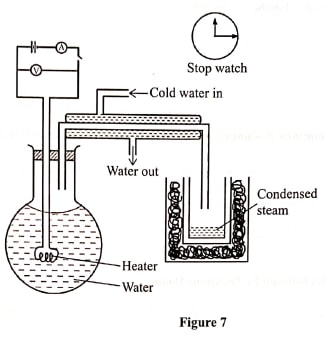
- Describe how the mass of condensed steam is determined. (3 marks)
- Other than mass and time, state two other measurements that should be taken during the experiment. (2 marks)
- Show how the measurements in (c)(ii) can be used to determine the specific latent heat of vaporisation of water. (2 marks)
- State the precaution that should be taken so that the mass of the condensed steam measured corresponds to the actual mass of steam collected during the time recorded in the experiment. (1 mark)
- State why it is not necessary to measure temperature in this set up. (1 mark)
-
- State what is meant by Brownian Motion (1 mark)
- Figure 8 shows the graph of velocity against time for a small steel ball falling in a viscous liquid.
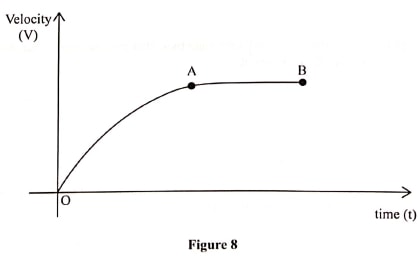
- Describe the motion of the steel ball as represented by part OA (1 mark)
- Explain why the velocity between A and B is constant. (3 marks)
- A student throws a tennis ball vertically upwards from the ground and it lands back after 8 seconds. (acceleration due to gravity g = 10 ms-2)
Determine the:- maximum height reached by the ball; (3 marks)
- velocity with which the ball hits the ground. (3 marks)
-
- Figure 9 shows a graph of pressure against temperature for a fixed mass of gas at constant volume.
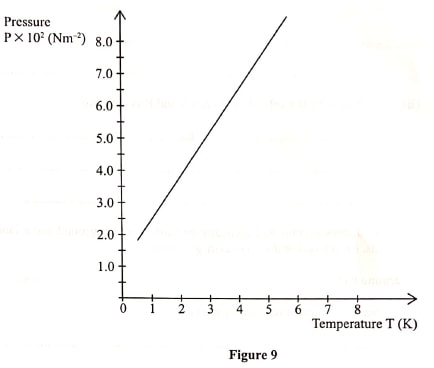
From the graph, determine the values of n and c given that P=nT + c where n and c are constants. (4 marks) - Explain why it is not possible to obtain zero pressure of a gas in real life situation. (2 marks)
- A fixed mass of a gas occupies 1.5 X 10-3 m3 at a pressure of 760 mmHg and a temperature of 273 K. Determine the volume the gas will occupy at a temperature of 290 K and a pressure of 720 mmHg. (3 marks)
- State any three assumptions made in kinetic theory of gases. (3 marks)
- Figure 9 shows a graph of pressure against temperature for a fixed mass of gas at constant volume.

MARKING SCHEME
SECTION A (25 marks)
- Actual reading = 0.38 mm
(error) = 0.03 −
Meter reading = 0.35 mm (1 mark) - On sucking air rushes into the straw√ through the hole making it difficult✓ to reduce pressure in the straw by sucking (2 marks)
- - Using detergents/impurities
- Raising the temperature (2 mark) - The flask absorbs heat from the hands and first expands✓ hence level of liquid✓ which expands more than the glass causing the rise.✓ (3 marks)
- Wax on rod B drops off first. ✓
The thicker rod conducts heat faster than the thinner one. ✓ (2 marks) -
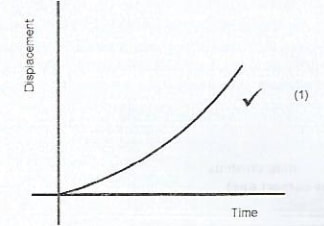 (1 mark)
(1 mark) - The box shifts the position of the center of gravity of the system towards the right hand to maintain equilibrium. The student leans in the opposite direction (2 marks)
- Taking moments about the fulcrum
Sum of clockwise moments = sum of anticlockwise moments
15x − 10(75x)
15x = 750 − 10x
25x = 750
x=30
hence fulcrum at 75 − 30 = 45
45+5 = 50 ✓
or
(x − 5)10 =(80 – x)15
25x=1250
x = 50cm (3 marks) - Radian is an angle subtended at the center of a circle by an arc of length equal to the radius of the circle. ✓
OR
r = 360/2π
1 radian = 57.290 (1 mark) - The assumptions are: the fluid is (2 marks)
- flowing steadily,
- incompressible,
- non-viscous. (any 2)
- ρ = m/v
ρ = 650g/800cm3
= 0.8125gcm-3 (3 marks) - C✓
It has a smaller diameter hence a higher spring constant (2 marks) - E(20N) ✓
F = ma, the smaller the mass, the higher the acceleration.✓
SECTION B (55 Marks)
-
-
-
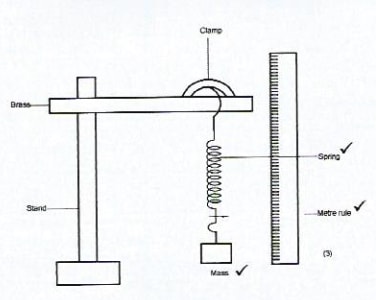
- - Force due to total mass hung. ✓
- Extension produced by hanging masses. ✓ (2 marks) - - Plot a graph of force against extension. ✓
- Determine the slope of the graph ✓
to get K = ΔF/Δe (2 marks)
-
- K= F/e ✓
0.40/0.60
= 0.667 ✓
∴ e = F/K
= 65/0.667
= 0.975cm✓
-
-
-
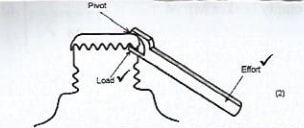 (2 marks)
(2 marks) - - Reducing the angle of inclination.
- Reducing the friction - using rollers, lubricants etc. (2 marks) -
-
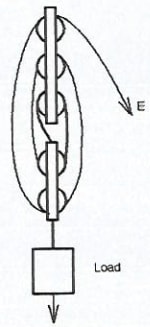
- V.R. - No, of strings supporting the load.
= 4.5 ✓ (1 mark) - η = MA/VR × 100 ✓
= 600 ÷ 200 × 100 ✓
5
= 60% ✓ (3 marks)
-
-
-
- Heat capacity is the quantity of heat energy required to raise the temperature of a substance by 1K. ✓ (1 mark)
- - Increase in pressure lowers the melting point while decrease in pressure raises/increases the melting point. ✓ (1 mark)
-
- - Measure the mass of the empty beaker M1 ✓
- Measure the mass of the beaker plus the condensed steam M2 ✓
- Get the difference between the two masses (M2 -M1)=M ✓ (3 marks) - - Voltage ✓
- Current ✓ - - Assuming no heat is lost,
- Heat produced by heater = Heat used to produce steam.
VIt = mLv
.: Lv=VIT/m (2 marks) - - Start timing when the steam drops start forming out steadily and stop immediately the beaker is withdrawn. ✓ (1 mark)
- Steam is produced at boiling point where temperature is constant.✓ (1 mark)
- - Measure the mass of the empty beaker M1 ✓
-
- Continuous random motion of particles. (1 mark)
-
- It accelerates, velocity increases. ✓ (1 mark)
- As the ball falls through the fluid, the viscous drag increases until the sum of the viscous drag and the upthrust becomes equal the weight of the steel ball, hence the resultant force becomes zero. (3 marks)
-
- S=ut +½gt2 ✓
But u=0
S = ½ x 10 x 4✓
= 20 m
= 20 m ✓ - V=u+at
= 10x4 ✓
= 40ms-1 ✓ (3 marks)
- S=ut +½gt2 ✓
-
- From y=mx+c, (P=nT + C)
- m is the slope of the graph hence n is the slope,
∴ slope n = (8−4) x 102 ✓
5 − 2
= 4/3 × 102
= 1.33x10 Nm-2K-1
n = 133Nm-2 K-1✓
C is the y intercept = 1.5x 102 Nm2 ✓(extrapolated) (4 marks) - It is not possible to reduce the pressure of a gas to zero since by then most✓ of the temperatures are very low hence the✓ gas liquefies.
- P1V1 = P2V2
T1 T2
760 x 1.5 x 10-3 = 720 x V2 ✓
273 290
V2 = 760x290x1.5x10-3
273 x 720
= 1.682x10-3 m3 ✓ (3 marks) - Assumptions of the kinetic theory of gases:
- Attraction of between the molecules is negligible
- Volume of the molecule is negligible compared to the volume of the container occupied by the gas.
- The molecules undergo elastic collisions.
- The length of time of a collision is negligible compared to the time between collisions. (Any three) (3 marks)
- From y=mx+c, (P=nT + C)
Download KCSE 2019 Physics Paper 1 Questions With Marking Scheme.
Tap Here to Download for 50/-
Get on WhatsApp for 50/-
Why download?
- ✔ To read offline at any time.
- ✔ To Print at your convenience
- ✔ Share Easily with Friends / Students


